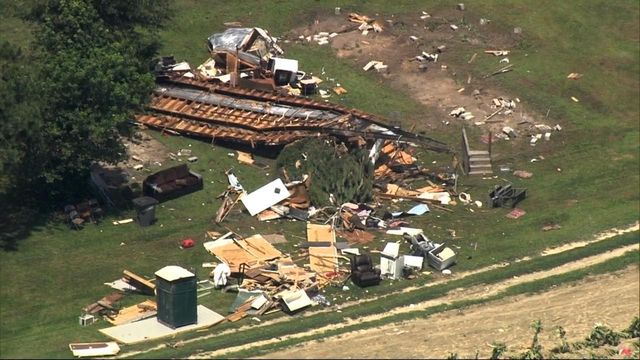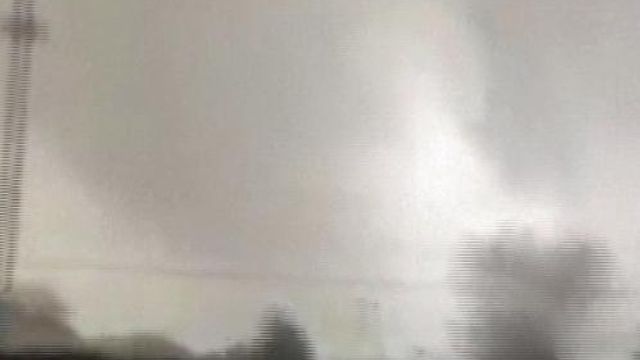Unforgiving nature: Countdown to the 20 worst natural disasters in the Triangle
The Research Triangle region, encompassing Raleigh, Durham, Chapel Hill, Cary, Apex and surrounding areas, has been witness to a series of natural disasters that have left an indelible mark on its history. From hurricanes and floods to tornadoes and winter storms, the Triangle has faced the formidable forces of nature.
Here is a recount 20 of the worst natural disasters that have shaped the resilience of this vibrant North Carolina community.
20. Snow and ice in January 2016:
In January 2016, the Triangle region experienced a profound transformation as snow and ice enveloped the area. This wintry onslaught triggered a cascade of events, from school and business closures to significant disruptions in transportation. The challenges of managing this winter weather were amplified by freezing rain, leading to widespread power outages that left a trail of downed trees and power lines across the state.
The aftermath of the storm saw numerous roads, including sections of Interstate 40 in Johnston County, closed due to debris. The impact on North Carolina was staggering, with approximately 147,000 people losing power. Wake County alone accounted for 50,000 of the total power outages. The resilience of the community was tested as it grappled with the aftermath of this winter weather phenomenon, navigating through closed roads, power loss, and the daunting task of restoring normalcy in the wake of nature's icy embrace.
19. December winter storm (2018):
In December 2018, an early-season storm swept through the Triangle, blanketing the area with a mix of snow and ice. This unexpected weather event posed significant challenges, causing power outages, transportation disruptions, and difficulties in navigating the wintry conditions. As up to 11 inches of snow fell in certain parts of the Triangle before transitioning to rain, the impact on the community was substantial.
The aftermath of the storm left approximately 200,000 people without power, highlighting the widespread consequences of the weather phenomenon. The resilience of the Triangle was put to the test as residents grappled with the dual challenges of icy conditions and power loss, underscoring the need for preparedness and adaptability in the face of nature's unpredictable twists.
18. Hurricane Dorian (2019):
Hurricane Dorian made landfall in the Bahamas on September 1, 2019, with sustained winds of 185 miles per hour. It made its way to the North Carolina coast on September 6, 2019, with rainfall totals of 5–10 inches and storm surge flooding in Cedar Island. The storm surge on Ocracoke Island was 4–7 feet, trapping several people in their attics and requiring rescue by boats.
17. Tornado outbreak (2020):
In April 2020, a tornado outbreak affected parts of North Carolina, including the Triangle. While the region wasn't the epicenter, the event emphasized the need for ongoing tornado preparedness and response measures. A small barn was damaged and trees were snapped and uprooted. This tornado moved through the southeastern suburbs of Charlotte. Several buildings in an industrial area near Pineville suffered roof damage, and the wall of a building under construction collapsed.
16. Rocky Mount tornado (2023)

A destructive EF-3 tornado hit North Carolina on July 19, 2023, north of Rocky Mount.
The EF3 tornado caused the area's largest employer, Pfizer, to shut down its plant in Rocky Mount until further notice. Pfizer employed more than 3,200 workers at its Rocky Mount plant.
15.Tropical Storm Fred (2021):

Fred caused power outages in the Dominican Republic. Over 500,000 people lost access to water after the country's aqueduct system failed. Flooding also affected Cuba. Fred also caused over 36,000 power outages in Florida. One person died in the state from hydroplaning. In North Carolina, Fred caused catastrophic flooding that destroyed many homes and claimed six lives.
14. Tornado outbreak (2018):
A tornado outbreak in April 2018 affected parts of North Carolina, including the Triangle. The most significant tornadoes were an EF1 that caused a fatality in Red Chute, Louisiana, early on April 14 and an upper-end EF2 tornado that impacted eastern sections of Greensboro, North Carolina, on April 15, causing 17 injuries.
13. Ice storm (2021):

A winter ice storm in February 2021 brought extreme cold temperatures and snow to the Triangle, causing widespread power outages and water supply issues.
12. Hurricane Isabel (2003):
While not a direct hit, Hurricane Isabel's impacts were felt in the Triangle in September 2003. The storm brought strong winds and heavy rainfall, causing power outages and localized flooding. Strong winds downed hundreds of trees of across the state of North Carolina, leaving up to 700,000 residents without power. Most areas with power outages had power restored within a few days. The hurricane directly killed one person and indirectly killed two in the state.
11. Hurricane Florence (2018):

Hurricane Florence, a slow-moving Category 1 hurricane, inundated the Triangle with heavy rainfall in September 2018, causing significant river flooding and disruptions. Florence is the fourth-deadliest hurricane on record for the state behind the unnamed storms in July 1916 and September 1883 and Hurricane Floyd in 1999. Damage from Florence in North Carolina was estimated at $17 billion. That's more than the combined damage from Hurricanes Floyd in 1999 and Matthew in 2016.
- Florence's Impact :: Hurricane Florence made landfall in North Carolina on Sept. 14, 2018
- Aftermath: North Carolina hurricane victims still feel left behind years later
10.The Great Ice Storm (2002):

An ice storm in December 2002 coated the Triangle in a layer of ice, leading to treacherous road conditions, power outages and damage to trees and infrastructure. The event highlighted the dangers posed by winter weather in a region unaccustomed to such conditions.
9.Hurricane Matthew (2016):

Hurricane Matthew generated devastating flooding across central and eastern North Carolina in October 2016 after the storm brushed past the coastline on Oct. 8, 2016. The hurricane dumped more than a foot of rain 100 miles inland, swelling streams and rivers to levels above what Hurricane Floyd produced in 1999. Raleigh saw a 1-day rainfall total of 6.45 inches on October 8, breaking the old record from June 2006. At least 26 people died in North Carolina and 31 died overall.
8. November tornado outbreak (2008)
The 2008 tornado outbreak in North Carolina occurred on November 14 and 15, 2008. The tornadoes killed two people and damaged homes as they moved from Robeson County to Halifax County. The strongest tornado was an EF3 that touched down near Wilson and Elm City, killing one person and injuring seven. Another EF2 tornado touched down near Kenly in Johnston County, killing one person.
7. Hurricane Floyd (1999):
Hurricane Floyd struck North Carolina on Sept. 16, 1999, just 10 days after Tropical Storm Dennis dumped 6 to 16 inches of rain across the eastern part of the state.
The ground was already saturated when Floyd dumped another 12 to 20 inches of rain. Rivers overflowed their banks and floodwaters began to cover roads and inundate entire communities.
Floyd killed 52 people in North Carolina – most of whom drowned as they tried to flee to higher ground in their cars. More than 87,000 people registered with the Federal Emergency Management Agency.
The floods destroyed about 8,000 homes and damaged more about 67,000. About 12,000 businesses were damaged.
The flooding caused about $6 billion in property damage and halted agricultural production in eastern North Carolina, causing more than $1 billion in farm losses. The floods killed nearly 3 million chickens and turkeys and more than 30,000 hogs.
6. The Great Blizzard of 2000:
January 25, 2000, brought the Great Blizzard to the Triangle, burying the region in heavy snowfall and causing widespread disruptions. This record-breaking storm, often dubbed the Raleigh Snowmageddon or Raleigh Snowpocalypse, lasted an entire day, leaving behind an awe-inspiring accumulation of 20.3 inches of snow. The city transformed into a winter wonderland, with piles of snow lingering for weeks and power outages challenging residents in the aftermath.The uncharacteristic winter storm tested the community's preparedness for extreme weather conditions.
5. Raleigh tornado outbreak (1988):
In March 1988, a series of tornadoes swept through North Carolina, affecting the Triangle.
The tornado remained on the ground for more than 80 miles, leaving destruction in several counties, including Wake, Franklin and Nash. The most intense damage occurred over northwestern Raleigh where the tornado traveled through densely populated areas near major intersections.
Four people were killed and more than 150 others were hurt.
4. Hurricane Fran (1996):
Hurricane Fran, a Category 3 hurricane, struck North Carolina in September 1996. The Triangle experienced severe flooding, power outages and extensive property damage, making it one of the most devastating hurricanes in the region's history.
What distinguished Fran was the amount of damage done to areas well inland. Hurricane Hugo also did measurable damage to the Charlotte region in 1989. Not since Hurricane Hazel in 1954 had a hurricane done this amount of bad in the Capital City.
“One of lessons we learned, you don’t have to live down at the coast to get slammed by a hurricane,” said hurricane historian Jay Barnes. “Even though the forecast track had projected that it was going to be turning more inland, I think a lot of people didn’t quite put two and two together to understand the Triangle area was going to get hit as hard as it did.”
With electricity knocked out for so many, most couldn’t even turn their television on. The WRAL News broadcast was simulcast on MIX 101.5, allowing some to keep up through a battery-powered radio or car stereo.
3. Tornadoes kill two dozen (2011):

On April 16, 2011, 30 tornadoes touched down in North Carolina for the greatest one-day total on record in the state.
A total of 24 people died that day in North Carolina, including eight people in central North Carolina. Hundreds more were injured.
Nine tornadoes occurred in the National Weather Service (NWS) Raleigh (RAH) County Warning Area (CWA). The areas impacted include the city of Raleigh along with Clinton, Cottonade, Holly Springs and Fayetteville. Among the nine, there were two EF-3 tornadoes, four EF-2 tornadoes and three EF-1 tornadoes.
At the Stony Brook North Mobile Home Park in Raleigh, 27 homes were destroyed and four children died.
2. Carolinas tornado outbreak (1984)
The tornado outbreak of March 28, 1984, was one of the deadliest, most destructive tornado outbreaks in the history of the two Carolinas. It is referred to as the Red Springs Tornado.

The final count shows 24 individual tornadoes touched down: 11 in North Carolina, 11 in South Carolina and 2 in Georgia. The human impact included 57 fatalities, (42 in North Carolina, 15 in South Carolina, none in Georgia) and 1,248 injuries (799 in North Carolina, 448 in South Carolina and 1 in Georgia).
Tornadoes ripped through Cumberland, Lenoir, Nash, Pitt, Robeson, Sampson and Wayne counties. They ranged from F2, F3 and F4 on the Fujita Scale.
1. Hurricane Hazel (1954):
Hurricane Hazel, which hit North Carolina in 1954, was the only Category 4 storm to ever make landfall in the state. While the Triangle wasn't the primary target, the storm brought heavy rainfall and high winds, causing widespread flooding and destruction. Wind gusts reached up to 110 mph in Fayetteville and 90 mph in Raleigh. Nineteen people were killed in North Carolina, with several hundred more injured; 15,000 homes were destroyed and another 39,000 were damaged. Damages in the Carolinas amounted to $163 million. Beach property incurred $61 million of damage alone.
Brunswick County, North Carolina, suffered the heaviest damage, where most coastal dwellings were either destroyed or severely damaged. For example, in Long Beach, North Carolina, only five of the 357 buildings were left standing.
The Triangle's history is marked by a diverse array of natural disasters, each contributing to the region's ability to adapt, prepare and recover. As the community continues to face the challenges posed by Mother Nature, these events serve as reminders of the importance of ongoing preparedness, resilient infrastructure and community solidarity in the face of the unpredictable forces of the natural world.























